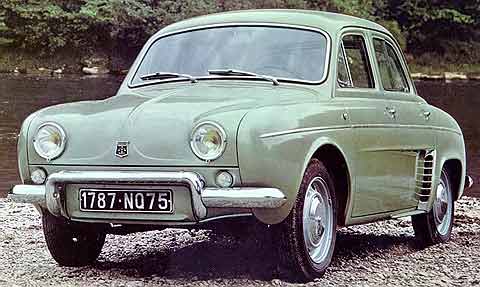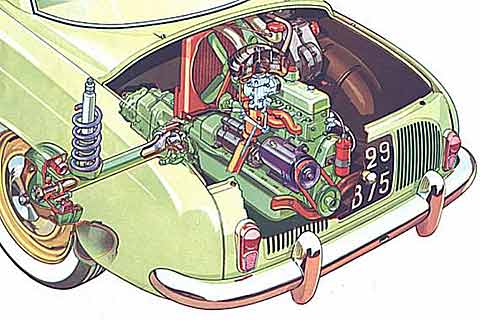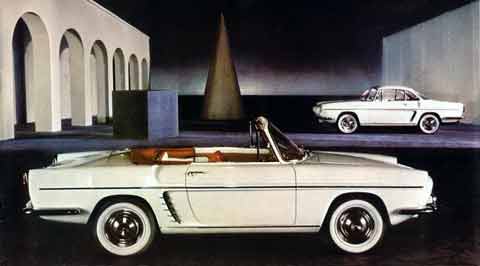 The Renault Dauphine, introduced in 1956, was based on the Renault 4CV that appeared immediately after World War IIThe Renault Dauphine, introduced in 1956.
The Renault Dauphine, introduced in 1956, was based on the Renault 4CV that appeared immediately after World War IIThe Renault Dauphine, introduced in 1956. The late 1950's and early 1960 saw a huge invasion of imports. The VW Beetle was by far the top seller, but for several years second place went to the Renault Dauphine. In 1958 over 26,000 Dauphines were sold, about half the number of VWs imported. The Dauphine, introduced in 1956, was based on the Renault 4CV that appeared immediately after World War II. A few 4CVs were imported.
The Dauphine was somewhat larger than the 4CV. Built on a 89 inch wheelbase -- VWs used a 94.5 inch one, it offered the convenience of four doors. At 155 inches, it was five inches shorter than the Beetle. All four passengers sat between the wheels and it had a completely flat floor for more inside room.
Like the VW, the engine was in the rear. Being water-cooled, the Dauphine had better heating. There was a rather large and useful trunk up front. The spare was located in its own compartment below the trunk accessed through an opening behind the license plate.
The Dauphine's mechanics were a bit disappointing and a big reason why you rarely see Dauphines anymore. The four cylinder, 845cc engine put out 32 horsepower. In 1961, the engine grew to 40 horsepower with the Gordini version. Originally, a three-speed transmission was used; VWs always had four speeds. In 1963, a four speed was optional.
 The 1959 Renault Dauphine had a 845cc water-cooled engine in the rear1959 Renault Dauphine Engine
The 1959 Renault Dauphine had a 845cc water-cooled engine in the rear1959 Renault Dauphine Engine These made a world of difference in performance, reliability, and suitability for American driving conditions. While the VW's ability to be driven at full-throttle continuously is legendary, this was not the case with the Dauphine. Although the Renault did have a top speed approaching 70 mph, it did not give you confidence that the engine would last very long if you drove it "all out."
Quite early there was a Ferlec semi-automatic transmission, basically an electrically operated clutch. Touch the gearshift and the clutch was electrically disengaged. You still had to select the gears manually. A fully automatic transmission was offered in 1963. Typically French, it was unique featuring a magnetic powder in place of a fluid coupling. When an electric current energized the magnetic field the powder solidified so the entire unit moved as one piece. The Renault automatic used a push button gear selector mounted on the dash.
Through the years the Dauphine stayed pretty much the same with refinements here and there. By 1967, the last year Dauphines were officially sold in the U.S., heavier metal was used in the body. There were also heavier bumpers and more luxurious interiors. The body was now anti-rust dipped, had more coats of paint, and was undercoated at the factory, greatly needed because Dauphines were rust prone, especially where salt was liberally applied to the roads in winter.
Like the Volkswagen Karman-Ghia, there was a more sporty version, the Caravelle. Like VW who went to Ghia, Renault turned to another Italian designer, Allemano, like VW who used the specialty body builder, Karmann, Renault used Brissoneau and Lotz of France for the coachwork.
 The Caravelle was originally introduced as the Floride, Renault felt this name was not right for California's hot import marketThe Renault Caravelle
The Caravelle was originally introduced as the Floride, Renault felt this name was not right for California's hot import marketThe Renault Caravelle Introduced originally in 1959 as the Floride, Renault felt this name was not right for California's hot import market. The Caravelle was offered as a 2+2 hardtop, convertible, and convertible with a removable hardtop. It shared its mechanics with the Dauphine. Because of better aerodynamics, the Dauphine engine could push the heavier cars to a top speed of 75 mph. The Floride/Caravelle was designed more for looks, than for performance. While many Caravelles found there way into the United States they were nowhere near as popular as the Karman-Ghia. In all some 117,000 Florides and Caravelles were built.
Where the Dauphines had the competition beat was in price. When introduced in 1956, the car cost $1650. However, unlike most items, the Dauphine went down in price. By 1967, the improved Dauphine cost a few dollars over $1400 making it one of the lowest priced cars available in the U.S.
Today, many vintage VWs are still on the road, but you seldom see a Dauphine even though over a quarter million Dauphines were imported. Lack of performance, marginal reliability and durability and not the best dealer and service network were all contributors.




